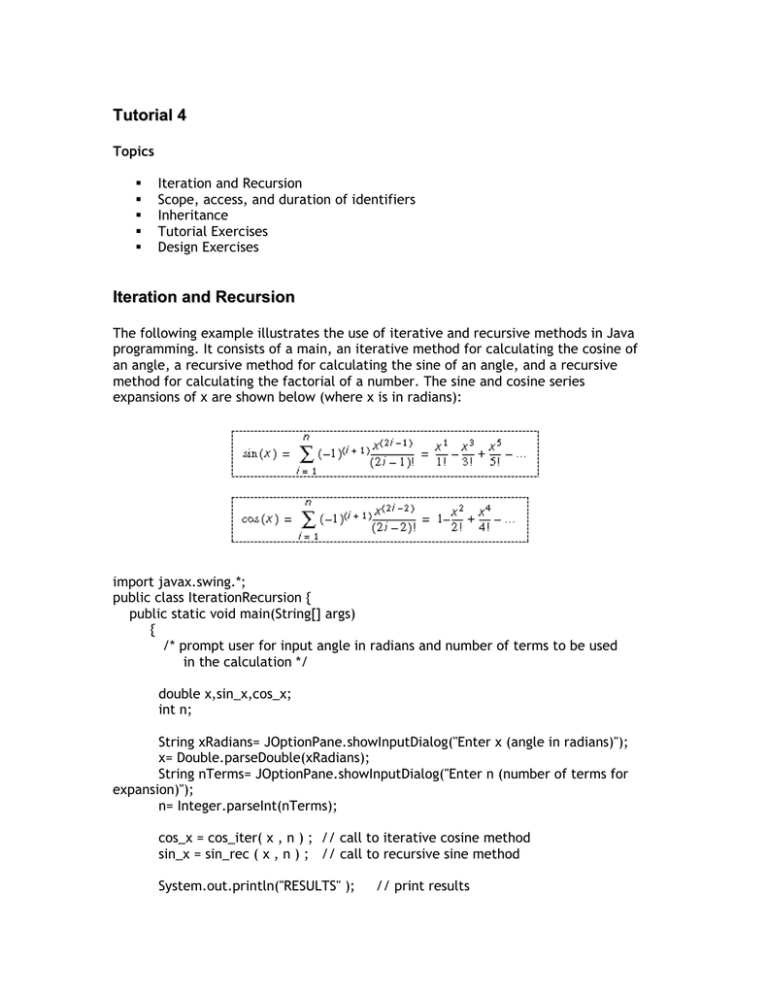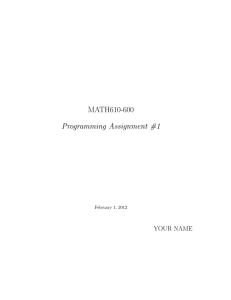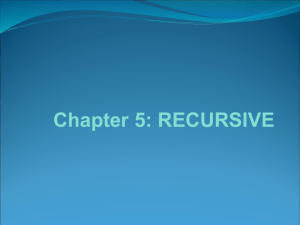T u t o
advertisement

Tutorial 4
Topics
Iteration and Recursion
Scope, access, and duration of identifiers
Inheritance
Tutorial Exercises
Design Exercises
Iteration and Recursion
The following example illustrates the use of iterative and recursive methods in Java
programming. It consists of a main, an iterative method for calculating the cosine of
an angle, a recursive method for calculating the sine of an angle, and a recursive
method for calculating the factorial of a number. The sine and cosine series
expansions of x are shown below (where x is in radians):
import javax.swing.*;
public class IterationRecursion {
public static void main(String[] args)
{
/* prompt user for input angle in radians and number of terms to be used
in the calculation */
double x,sin_x,cos_x;
int n;
String xRadians= JOptionPane.showInputDialog("Enter x (angle in radians)");
x= Double.parseDouble(xRadians);
String nTerms= JOptionPane.showInputDialog("Enter n (number of terms for
expansion)");
n= Integer.parseInt(nTerms);
cos_x = cos_iter( x , n ) ; // call to iterative cosine method
sin_x = sin_rec ( x , n ) ; // call to recursive sine method
System.out.println("RESULTS" );
// print results
System.out.println(" sin(" + x + ") = " + sin_x);
System.out.println(" cos(" + x + ") = " + cos_x );
System.out.println(" (Using " + n + " expansion terms)" );
}
private static double cos_iter(double angle , int n)
{
// Iterative method to calculate cosine
double sum = 0.0 ;
for(int i=1 ; i <= n ; i++)
{
if ((i+1)%2==0)
sum += Math.pow(angle,(2.0*i-2.0)) /factorial(2*i-2);
else
sum -= Math.pow(angle,(2.0*i-2.0)) /factorial(2*i-2);
}
return sum ;
}
private static double sin_rec (double angle, int i)
{
// Recursive method to calculate sine
if(i==1)
return angle;
else if ((i+1)%2==0)
return Math.pow(angle,2.0*i-1.0)/
factorial(2*i-1)+sin_rec(angle,i-1);
else
return -Math.pow(angle,2.0*i-1.0)/
factorial(2*i-1)+sin_rec(angle,i-1);
}
private static int factorial(int n)
{
// computes the factorial of n
if(n==0)
return 1;
return ( n * factorial(n-1));
}
}
Understanding recursive methods
A method is said to be recursive if it calls itself. This concept may be difficult to
grasp, and therefore needs some explanation. In a non-recursive context, when you
call a method from another method, here is what happens.
Suppose you are calling the method func() from the main() method. The computer first
executes the statements at the beginning of the main() method. But, when it reaches
the call to func(), the computer conceptually (though not actually) makes a copy of
the code you wrote for func(), and starts executing the code in this copy with the
correct arguments. Whether or not a return statement is at the end of the called
method, the closing brace } tells the computer to go back to the execution of the rest
of the main() method.
The following figure illustrates what happens during a recursive call.
Let's imagine that the method func() is a recursive method. When this method
executes, at some point, it calls itself. As the diagram above shows it, there is no loop
involved here, since a copy of the method is made. Then, the statements in this copy
start being executed, but with different arguments this time. If another recursive
called is triggered, another copy is made. This goes on and on, until finally, in one
copy of the method func(), the arguments allow to reach the base case, and allow the
copy to "return," i.e. to pass the control back to its parent. The parent takes control,
executes the rest of its statement, and in its turn, passes the control to its parent.
This goes on until the control is back to the initial calling method, which has been
waiting for all this time and can now finish. Termination Criteria
Given the process explained in the previous section, if you don't want to generate an
infinite number of copies of a recursive method, the latter should have a base case (or
cases) that is tested for upon entry to the method. The base case is used to determine
whether the recursion should terminate. This is exactly similar to the conditional
statements in a while or a for loop which are used to terminate the iteration. For
example, the following method computes the sum of the first n positive integers using
n <= 1 as the termination criteria. Note that the termination criteria is usually the first
segment of code in a recursive method.
int sum(int n) {
if ( n<=1 )
// if n <= 1, the recursion terminates
return n;
// This is the base case
else
return (n+sum(n-1)); // otherwise, n is reduced by 1 each time
}
// until the termination criteria is met
A smaller problem
The typical structure of a recursive method involves a call to itself with a smaller
problem after the termination criteria has been tested. This statement is necessarily
vague and must be read with some caution. Particularly, it may not be obvious how to
call a method with a smaller problem. Or even when you are given a method, where it
is calling itself with a smaller problem and what the relation of the smaller problem to
the larger problem is. The essence of writing recursive code is to realize how to
decompose problems into smaller ones, which have all the characteristics of the larger
problems.
Visualizing Recursion
One way of visualizing recursive methods is by using a tree format. As an example,
for the above method sum(), sum(4) can be visualized as follows. You can try building
a similar tree for the factorial method from the last example.
Scope, access, and duration of identifiers
Each identifier in a program has associated duration and scope (The name of a variable
or method is called an identifier). The scope and access rules determine where an
identifier can be referred to in a program. Scope
The scope of a variable is the set of statements in the program, which can refer to
that variable. The scope for an identifier can be either a class scope or block scope.
Class scope
... begins at the opening left brace '{ ' of the class definitions and end at the closing
right brace '}' of the class definition. Methods and instance variables of a class have
class scope. Class scope enables members of a class to directly invoke all methods
defined in the same class or inherited into the class and also to directly access the
instance variables defined in the class.
Block Scope
... begins at the identifier's declaration and ends at the terminating right brace '}' of
the block. Method parameters and local variables (declared at the beginning of a
method and variables declared anywhere in a method) has block scope. When blocks
are nested an identifier in a outer block cannot have the same name as an identifier in
an inner block, but if a local variable has the same name as an instance variable then
the instance variable is hidden within the block.
Accessibility of Class members
Java allows access specifiers for members of a class variables and its methods. There
are four access specifiers: public, private, protected and package (default). The
access specifier 'protected' will be dealt with later. To declare a variable to be of a
particular access specifier type, add the access specifier to the variable declaration.
The following chart shows the access level permitted by each specifier
Specifier class subclass package world
private
yes
no
no
no
public
yes
yes
yes
yes
package
yes
no
yes
no
The first column shows the access specifier and the other columns show who has
access to members with the corresponding access specifier. The column, class
indicates the same class in which the member is declared. The column, subclass,
indicates the subclasses of this class. The column, package ,represents the package of
the class in which the member variable is declared and world indicates all classes.
Accessibility of Classes
Classes also can have access restrictions. A class can be declared public, private or
package (default).
public classes can be instantiated anywhere in a program.
private classes can only be instanced from statements in the same source code
file.
package classes can be instanced from any code in the same package
Java also allows classes to be defined inside other classes. this "inner classes" have
scope restricted to their enclosing classes. i.e. any code in inner classes has access to
all members of the enclosing class and vice versa. We discuss those later.
Duration
The duration determines the period during which an identifier exists in the memory of
your computer.
Local variables
Local variables have automatic duration. Automatic duration variables are created
when the program control enters the block in which they were crated and are
destroyed when the program control exits the block.
Static Declaration
Each object of a class has its own copy of the instance variables. But sometimes, when
we want classes to share a member between them, we use static member
declaration.
A static class member exists even when no objects of that class exist. Static members
exist from the point at which the class that define them is loaded into the memory.
But it should be borne in mind that even though the names of static members are valid
their use should also take into account their scope.
If a method is declared static then the method can be called (provided access rules
permit this) using the class name. A static method cannot access non static class
members. Here is an example:
public class WelcomeConsole {
static int count=0;
private int dummy=0;
public static void main(String[] args){
dummy++; // illegal - non static member
count++;
System.out.println(count);
System.exit(0);
}
}
The main method is declared static so that this method can be called without
instancing this class and the public access specifier is provided because this main
method can be called from anywhere (command line). If a class has a public static
void main( ) (main does not return anything ) method then this class can be run by
typing the virtual machine name followed by the class name. Final declaration
If a variable is declared final then it tells the compiler that its value will never be
changed. A class declared final cannot be extended (inherited from). A method
declared final cannot be overridden in a subclass. Also static and final methods are
implicitly final.
Tutorial Exercises
1. Recursive methods work by calling themselves to solve sub problems until the sub
problems are simple enough for them to solve directly. Recursive methods include
two parts: the part that handles the simplest cases is called the base part; the portion
that transforms more complex cases is called the recursive part. For the following
code, identify the base part and the recursive part of the method
"recursivePowerOf2", then write down the result of the following program.
public class MyClass {
public static void main (String argv[]) {
System.out.print("2 to the 4th power is ");
System.out.println(MyClass.recursivePowerOf2(4));
System.out.print("2 to the 10th power is ");
System.out.println(MyClass.recursivePowerOf2(10));
}
public static int recursivePowerOf2(int n) {
if (n==0)
return 1;
else
return 2*recursivePowerOf2(n-1);
}
}
2. Access:
For the following code, please find the four statements that are illegal and explain
why.
package edu.mit.course.100.tutorial4.set1;
class TestA{
private int privateData;
public int publicData;
int defaultData;
public TestA( ){
privateData=0;
publicData=1;
defaultData=2;
}
private void privateMethod ( TestA a ) {
System.out.println(privateData);
System.out.println(a.privateDate);
}
private void publicMethod ( TestB b , TectC c) {
System.out.println(b.publicData);
System.out.println(b.defaultData);
System.out.println(b.privateData);
System.out.println(c.defaultData);
}
}
// -------------
another package -----------
package edu.mit.course.100.tutorial4.set1;
class TestB{
private int privateData;
public int publicData;
int defaultData;
public TestB () {
privateData=0;
publicData=1;
defaultData=2;
}
private void privateMethod () {
TestA a = new TestA();
System.out.println(a.privateData);
}
private void publicMethod ( TestC c ) {
TestA a = new TestA();
TestB b = new TestB();
a.publicMethod(b,c);
a.privateMethod(a);
}
}
// ---------- and another package --------------package edu.mit.course.100.tutorial4.set2;
class TestC{
private int privateData;
public int publicData;
int defaultData;
public TestC( ){
privateData=0;
publicData=1;
defaultData=2;
}
}
Design Exercises
1. Design a new MyMath class that implements the following methods: sum, factorial,
a^b (b is a non-negative integer), sin, and cos. All these methods should be
implemented as static methods. Write another class to test your methods.
For instance, your program should be able to output the following:
-sum(5) is 15
-factorial(5) is 120
-power(4, 5) is 1024
-sin(5, 6) is -1.1336172989818796
-cos(5, 6) is -0.16274663800705413
Hint: all these methods should be implemented either as recursive methods or as
iterative methods.
2. Redesign the HeatPlate class (the last slide from Lecture 11)
Discuss the pros and cons with your partner of various changes, such as:
Should you store Re, Nu? If you do, how can you be sure they’re computed and
up to date? Does this depend on whether there are setXXX() methods in the
class?
Should you store hPlate, etc?
Methods calling methods can be confusing. Should you change that?
Housekeeping items (minor):
o Get rid of the stupid retvals
o Rename arguments to avoid using ‘this’? (Debatable)
Should any of these methods be static?
Compile and test/read with debugger






